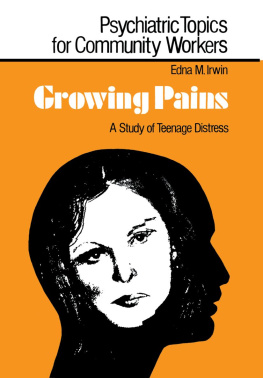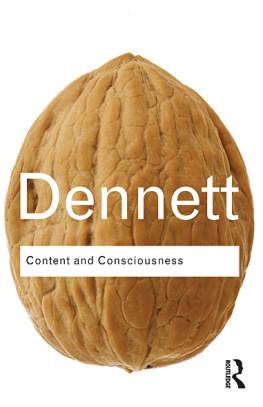GROWING PAINS
a study of teenage distress
Edna M. Irwin
Consultant Psychiatrist
Hollymoor Hospital,
Birmingham
First published 1978 by
THE WOBURN PRESS
Published 2013 by Routledge
2 Park Square, Milton Park, Abingdon, Oxon OX14 4RN
711 Third Avenue, New York, NY, 10017, USA
Routledge is an imprint of the Taylor & Francis Group, an infoma business
Copyright 1978 Edna M. Irwin
All rights reserved. No part of this publication may be reproduced in any form or by any means, electronic, mechanical, photocopying, recording or otherwise, without the prior permission of The publisher in writing.
ISBN 13: 978-0-713-00166-2 (hbk)
Text set in 11/12 pt Photon Times
Contents
Working with adolescents is never easy, as any school teacher will confirm. Working with psychiatrically-disturbed adolescents is a highly complex and demanding task, which requires a certain type of dedication which relatively few people possess. This is true of all the personnel concerned, whether they be from psychiatric, social work, nursing or other disciplines. People who can work successfully with the disturbed adolescent are, therefore, a highly selected group and the group is quite a small one. However, although their numbers are small, their work is very important. This is a fairly new field and it is one about which people, either professional or lay, know very little. Therefore, it seems right to illumine this area for the non-specialist and this is what Dr. Irwin has set out to do in this book, in my opinion, highly successfully.
Adolescents have always been with us, but there is still a tendency to regard them as overgrown children or under-developed adults. Lip-service is paid to the concept that they have problems specific to themselves, but when these problems become acute, frequently there are no facilities available to help them and attempts are made to squeeze the adolescent into some inappropriate therapeutic mould. Fortunately, this situation is beginning to change and there is increasing interest and concern for their welfare.
I have said that work with them is important and I would reiterate this. Adolescence is a kind of psychiatric crossroad, at which a number of serious disorders may appear and the earlier they can be recognised and treated the better; on the other hand, it is also a time at which the effects of unduly harmful events occurring in childhood may still be undone and much positive benefit brought about for the individuals future mental health. So, it can be viewed as a period when, at least potentially, useful interventive and preventive work may be carried out.
As Dr. Irwin points out, despite the many problems of being a teenager, most adolescents are remarkably healthy and it is a small minority who require psychiatric help. But, untended disorders at this age may produce a very prolonged period of ill-health and malfunctioning, with severe repercussions on the family, the school and the various other organisations with which the disturbed individual comes in contact. Society itself may suffer, since not too infrequently, teenage disturbance may overflow into delinquency and other anti-social behaviours. A great deal of crime is committed these days by youngsters, including a sizeable proportion of violent crime. These phenomena will not disappear of their own accord and our habit of trying to ignore them is wearing very thin at present.
Adolescents always seem to create more problems than their numbers justify. This is common knowledge and it applies to psychiatric illness just as much as to anything else. But if you were to judge how important psychiatric disorder of adolescence was from its representation in standard textbooks, you would be forced to conclude that it was quite a minor cause for concern. Or, if you were to consider how little there is in the general literature that is truly informative about adolescence, normal and abnormal, you might decide that perhaps you were mistaken and that teenagers, after all, lived a singularly uneventful life!
We know this is not true. A growing number of professional and voluntary workers are developing a rapidly increasing awareness of, and expertise in, the psychological problems of this particular age group. As one of the small group of adolescent psychiatrists, and as leader of an inter-disciplinary therapeutic team, Dr. Irwin is in an excellent position to provide us with an overview of her subject and she has done this well. Her book was designed especially for those interested in the social work aspects of adolescent mental disorders and I am confident that it will fill an increasingly noticeable gap in the literature for workers in this area. In addition, she has much to say of interest and common sense that will be of value to the involved layman (including the interested parent) at one end, and the nurse, medical practitioner, psychologist and school teacher at the other. I learned a great deal from her book and enjoyed her sense and sensibility approach, as I am quite sure you, the reader, will do.
Alistair Munro
Toronto, 1977
On opening a hospital unit for emotionally disturbed adolescents, the author was faced with an in-service training programme for a multi-disciplinary staff team. The senior nurses at the unit had State Registration in psychiatric and general nursing, but had no knowledge of child and adolescent development. The occupational therapist was in a similar situation. The teachers had knowledge of child and adolescent development, but were ill-equipped to deal with some of the psychiatric problems with which they were presented. As the unit became established, students from various disciplines rotated through the unit, and it was difficult to provide them with the information that they wished to have within the short space of time that they were attached to the adolescent unit. Information was available, but it was widely scattered in books and journals and, therefore, not easily accessible. The ensuing chapters are the outcome of the authors attempts to minimise the gaps between the various disciplines and provide a basic text for workers in this area.
As with other residential establishments for disturbed youngsters, hospital adolescent units rely heavily on the untrained, mature adult. With time, such staff acquire a sophisticated knowledge about the emotional problems of adolescence, but their introduction to an adolescent unit can be a threatening experience, as they have little idea of what to expect. Whilst no extensive knowledge is required to have some awareness of the nature and treatment of common physical ailments, for example, appendicitis, cancer and diabetes, even well-informed lay people have little knowledge of the different types of psychiatric illness and assume that all mental illness is associated with a sinister prognosis. New staff find themselves at a loss to answer questions posed by a young patient, and staff ignorance contributes to feelings of insecurity amongst both staff and patients. The ensuing chapters are an attempt to reduce this unawareness.
As there is a considerable literature available on child care, social work and education, the author has chosen to confine herself to the more specifically psychiatric aspects of teenage disturbance, so that many areas of concern, such as teenage violence, are not considered. To a large extent, the writer has adhered to the so-called medical model in which a clinical history is used to make a diagnosis; on the basis of this, treatment is prescribed and a prognosis is made. Some repetition between chapters is deliberate, so that if, for example, a teacher is presented with a pupil who is considered to suffer from anorexia nervosa the appropriate chapter may be consulted. To facilitate access to further knowledge, references and a selection of further reading is appended at the end of each chapter.






